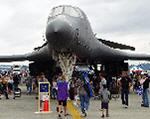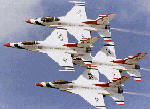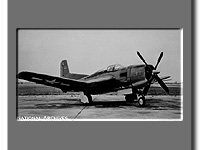
|
Description
| Manufacturer: | Douglas |
| |
| Base model: | BTD | ||
| Designation: | BTD | ||
| Version: | -1 | ||
| Nickname: | Destroyer | ||
| Equivalent to: | BTD BTDBTD | ||
| Designation System: | U.S. Navy / Marines | ||
| Designation Period: | 1942-1945 | ||
| Basic role: | Bomber-Torpedo | ||
Specifications
| Length: | 38' 7" | 11.7 m | |
| Wingspan: | 45' | 13.7 m | |
| Gross Weight: | 19,000 lb | 8,616 kg | |
Propulsion
| No. of Engines: | 1 | ||
| Powerplant: | Wright R-3350-14 | ||
| Horsepower (each): | 2300 | ||
Performance
| Max Speed: | 344 mph | 553 km/h | 298 kt |
Known serial numbers
Examples of this type may be found at
| Museum | City | State |
| Florence Air and Missile Museum | Florence | South Carolina |
Recent comments by our visitors
| Ed Flesch Big Flats, NY | The Wings of Eagles Discovery Center has a new campus at 339 Daniel Zenker Drive, Exit 50, I-86. 607-358-4247, www/wingsofeagles.com. 07/03/2013 @ 09:18 [ref: 67924] |
| Ed Flesch Big Flats, NY | The BTD shown in this site is no longer at the Florence Air and Missile Museum. It is at the Wings of Eagles Discovery Center, 17 Aviation Drive, Horseheads, New York, on the Elmira-Corning Regional Airport, Exit 50 off I-86. It is on loan from the National Museum of Naval Aviation(NMNA), Pensacola, FL. It is fully restored except for the painting but may not be flown, according to the agreement with NMNA. Go to www.wingsofeagles.com. 10/17/2007 @ 16:33 [ref: 18223] |
| Ed Flesch Big Flats, NY | The BTD shown in this site is no longer at the Florence Air and Missile Museum. It is at the Wings of Eagles Discovery Center, 17 Aviation Drive, Horseheads, New York, on the Elmira-Corning Regional Airport, Exit 50 off I-86. It is on loan from the National Museum of Naval Aviation(NMNA), Pensacola, FL. It is fully restored except for the painting but may not be flown, according to the agreement with NMNA. Go to www.wingsofeagles.com. 10/17/2007 @ 16:33 [ref: 18222] |
| Adrian Bain Sydney, OTH | According to the Discovery channel\'s \"Wings\" program of 1991, concerning the AD Skyraider, it says that ww2 combat experience had shown that the rear gunner had proved no deterrent to enemy fighters and was therefore redundant, so too the \"observer\" - the third crew member in Torpedo planes of the time was wasted in a modern airframe. Accordingly, the Navy\'s specifications in 1944 called for a single seat attack plane.
It goes on to say that the BTD-1 design, started in 1942 was based on outdated thinking (that is additional crewman/gunner layout) and was clearly inferior to competing designs, such as the Martin AM Mauler, Ed Heineman of Douglas asked for Navy permission to withdraw the BTD-1 from consideration and apply any unused funds to develop a new design and re-enter the contest. Apparently Heineman and his team then worked through the night on a new design and submitted the outline the following day with a technical description to the navy. The navy was sufficiently impressed and the new Douglas design went on to become the AD Skyraider. Hope this answers some of the questions 09/04/2007 @ 22:36 [ref: 17837] |
| Mike Link Greenville, SC | In Bob Kowalski and Steve Ginterís book on the Douglas XSB2D-1 & BTD-1 Destroyer, they indicate that two XSB2D-1ís and twenty-six BTD-1ís were manufactured, both using the new Wright R-3350 engine as specified by the Navy. Two or three of the BTD-1ís were modified to incorporate a Westinghouse WE19 jet engine in addition to the R-3350. The XSB2D-1 had a two man crew (pilot & gunner/observer). The BTD-1 had only a pilot, but a few of the BTD-1ís had a plexiglass hatch installed on the turtledeck, which gives the impression that another crew seat may be installed. The only mention of a crash in the book is of a XSB2D-1 (BuNo 03551) which was destroyed during a test flight on 24 May 1946, 30 miles south of NAS Moffett near Las Gatos following a fire that started in the R-3350ís induction system. Their book provides a good history of this intersting aircraft. 03/29/2006 @ 12:41 [ref: 12967] |
| Rob Coffman , VA | Might want to rethink the comment about this airplane being ONLY a single seater -- take a closer look at the photos on this page. I can see two maybe three sets of clear panels in the fuselage that look very much like separate canopies, leading me to think that the particular aircraft shown had more than one seat. This thing is about the same size as a Skyraider and there were several models of A-1s that carried a couple of guys inside the fuselage. Never say never because anything is possible -- and even likely -- when you're talking about military airplanes. 02/05/2006 @ 07:36 [ref: 12419] |
| Rick Smith , PA | The crashed aircraft was most likely a XSB2D-1.
http://history.nasa.gov/SP-4302/ch2.4.htm About 2/3 down the page. 09/05/2005 @ 12:47 [ref: 11155] |
| Fred Morse Oceanside, NY | I WOULD THINK THAT THE TYPE ENGINE MENTIONED IN THE DESCRIPTION SHOULD BE RE-CHECKED. I FORGET WHEN THE 3350 CAME IN TO BEING BUT I DON'T BELIEVE THAT IT WAS AS EARLY AS 1942-45 08/05/2005 @ 17:36 [ref: 10929] |
| Brian Kim Neville Severn, MD | The BTD-1, nicknamed 'Destroyer' was based off of the older XSB2D-1 'Turkey,' but was even more overweight. It only carried one person, and to the best of my extensive knowledge, no BTD-1s crashed. This means three things, no one could have died in a crash as no BTD-1s crashed, even if one did crash, the passenger couldn't have been killed because the BTD-1 only carried one person, and it would be a bad idea to try to fly one, since they were known to have poor handling due to their weight. 03/03/2005 @ 19:53 [ref: 9601] |
| Mark Darling Ithaca, NY | The BTD-1 at the Wings of Eagles Warplane Museum is being restored, it is on permanent loan from the US NAvy under the stipulation that it never be flown. It was acquired from the museum in Florence, SC.
MD 08/09/2004 @ 13:04 [ref: 8008] |
Recent photos uploaded by our visitors








